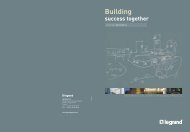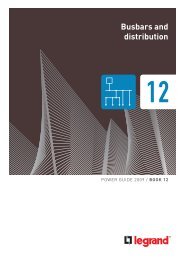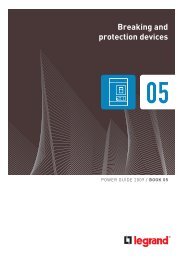Create successful ePaper yourself
Turn your PDF publications into a flip-book with our unique Google optimized e-Paper software.
5<br />
44<br />
THE GROUP’S BUSINESS<br />
<strong>Legrand</strong>’s business<br />
More specifi cally, the industrial divisions continuously aim to<br />
increase their industrial profi tability and reduce capital employed<br />
by:<br />
■<br />
■<br />
■<br />
■<br />
■<br />
optimizing and streamlining industrial sites;<br />
specializing plants by product line or technology to reach<br />
critical mass. These specialized plants allows <strong>Legrand</strong> to<br />
centralize know-how and act as a benchmark for the rest of<br />
the Group with respect to their specifi c industrial processes;<br />
systematically applying a “make or buy” approach for all new<br />
projects to determine when capital should be invested in new<br />
production assets as opposed to outsourcing production to<br />
subcontractors;<br />
creating lean manufacturing workshops on sites in order to<br />
optimize productivity and capital employed; and<br />
transferring production to other units within the Group which<br />
carry lower production costs. In <strong>2007</strong>, 54% of the Group’s<br />
production employees are located in low cost countries, as<br />
compared with 31% in 2002.<br />
As a result of the continuous optimization policy of its industrial<br />
divisions, <strong>Legrand</strong> has closed or sold 25 plants over the past<br />
fi ve years (notably in Austria, Brazil, South Korea, France, Italy,<br />
Morocco, Mexico, the Netherlands, Peru, the United Kingdom<br />
and the United States).<br />
The savings realized from <strong>Legrand</strong>’s industrial optimization<br />
policy have helped to fi nance:<br />
■<br />
■<br />
■<br />
strengthening of the Group’s front offi ce operations, particularly<br />
in the increase of its sales force;<br />
the design and launch of new products; and<br />
acquisitions.<br />
■ 5.1.6.1.2 - RESEARCH AND DEVELOPMENT<br />
On a recurring basis, <strong>Legrand</strong>’s research and development<br />
expenses (before purchase accounting charges relating to<br />
the acquisition of <strong>Legrand</strong> France and including capitalized<br />
development expenses) as a percentage of net sales represented<br />
between 4% and 5% of net sales. In particular, our research and<br />
development staff increased by 19% between 2004 and <strong>2007</strong>. Thus,<br />
<strong>Legrand</strong> launched more than 50 new product ranges for <strong>2007</strong><br />
alone and more than 80 new product ranges between 2005 and<br />
2006 (see section 5.1.5 of this <strong>reference</strong> <strong>document</strong>)<br />
■ 5.1.6.1.3 - PURCHASING<br />
As part of its industrial reorganization starting in 2003, <strong>Legrand</strong><br />
implemented a more centralized purchasing organization to<br />
optimize its purchasing and improve its purchasing profi tability.<br />
This purchasing organization now reports directly to the head of<br />
purchasing and is characterized by:<br />
■<br />
a purchasing structure that is adapted to the Group’s suppliers’<br />
worldwide organization, which puts it in an equal bargaining<br />
position (locally or by geographical zone) with them so that the<br />
Group may benefi t from economies of scale;<br />
REFERENCE DOCUMENT <strong>2007</strong> - legrand<br />
■<br />
■<br />
purchasing management led by user/buyer teams which aim<br />
to maximize the value of the Group’s purchasing by making<br />
pricing a criterion of supplies selection; and<br />
the involvement of buyers in the research and development<br />
process to capture savings at the very beginning of product<br />
development.<br />
Through the channels of the Group’s new purchasing organization,<br />
purchasing is optimized through the following means:<br />
■<br />
■<br />
■<br />
■<br />
■<br />
■<br />
< Contents ><br />
consolidating purchasing for all divisions of the Group;<br />
purchasing of raw materials and components from lower cost<br />
countries. Since 2003, <strong>Legrand</strong> has opened an international<br />
purchasing offi ce in each of Asia, Latin America and Eastern<br />
Europe, which allows it to purchase raw materials and<br />
components from lower-cost countries and to purchase certain<br />
raw materials and components for the entire Group at a global<br />
level;<br />
adapting the Group’s consumption of raw materials and<br />
components to fi t with those materials readily available on<br />
the market;<br />
continuously optimizing the Group’s supply specifi cations for<br />
raw materials and components to meet the Group’s actual<br />
needs;<br />
adapting industrial processes to optimize the Group’s cost<br />
structure; and<br />
adapting its corporate habits, including those relating to<br />
transportation (personnel and materials), supplies, facilities,<br />
offi ce management and information technology, to conform<br />
with best practices.<br />
■ 5.1.6.1.4 - LOGISTICS AND INVENTORY<br />
MANAGEMENT<br />
<strong>Legrand</strong>’s primary logistical concern is ensuring timely product<br />
delivery to its customers by adapting the volume and nature of<br />
customer shipments to the storage, preparation and transport<br />
costs. Recent initiatives to streamline inventory management<br />
have helped the Group to decrease its ratio of inventory value to<br />
consolidated net sales from an historical level of 17% on average<br />
between 1990 and 2001 to 15% on average between 2002 and <strong>2007</strong>.<br />
To this end, <strong>Legrand</strong> developed and refined its industrial<br />
management methods, such as Kanban, the Group’s just-in-time<br />
production management system that manages parts required<br />
for product assembly, and Manufacturing Resources Planning 2,<br />
a production management system that enables the Group to<br />
optimize the use of all manufacturing resources.<br />
In each market where it distributes its products, <strong>Legrand</strong><br />
maintains logistics, inventory management and distribution<br />
systems adapted to local market conditions. The Group’s operating<br />
subsidiaries take orders and ship products out of their own<br />
inventory. These inventories include both products manufactured<br />
locally and products manufactured in other jurisdictions. The<br />
Group has implemented automated and computerized systems for<br />
the majority of its warehouses. The Group’s principal warehouses<br />
(located in France and Italy and which supply most of the countries<br />
1<br />
2<br />
3<br />
4<br />
5<br />
6<br />
7<br />
8<br />
9<br />
10<br />
11<br />
12<br />
13<br />
CT<br />
A








